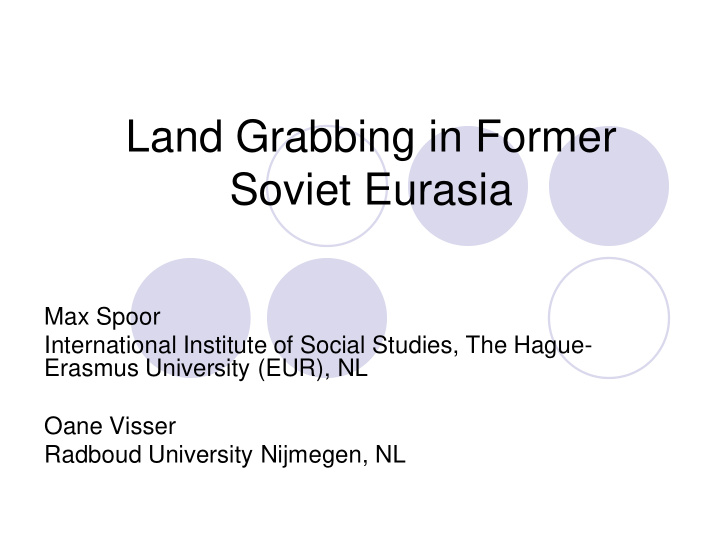



Land Grabbing in Former Soviet Eurasia Max Spoor International Institute of Social Studies, The Hague- Erasmus University (EUR), NL Oane Visser Radboud University Nijmegen, NL
Introduction Land grabbing debate : Focus on Africa,also Latin-America, Asia. Ignorance of post-Soviet Eurasia
Introduction (2): Post-Soviet Eurasia Focus on: Russia, Ukraine, Kazakhstan Large deals Central questions: What is the magnitude of the process? What kind of investors are involved? What are the socio-economic consequences? (esp. access to land)
Prospects for agriculture in the region Short term: Abundance of unused & underutilized land Low land prices (compare with LA) Very fertile land; increase in yields Reasonable Infrastructure (Black-Earth, Siberia) Long term: Climate change? Water resources’ availability are good Food-feed-fuel “basket” of Europe/the World?
Land acquisitions: Domestic investors: 1990s: economic decline; land reform (“share- based”) End 1990s/ early 2000s: revival of agriculture: energy companies start investing in land (“vertical integration”) From 2002 onwards: industrial & trade companies; investment funds invest in land
Land Acquisitions (2) Type of international investors (through joint ventures, leasing arrangements, full subsidiaries): Ukraine & European Russia: Western companies, Gulf countries Siberia & Kazakhstan: Asian countries (China, S- Korea, Japan) Central Eastern Europe (Western Europe) Difference in strategy (type of investor, workforce) Magnitude: Large-scale land acquisitions (domestic, International)
Land availability and population density in the FSU target countries and the investor countries Countries Arable land (hectares per Density (/km 2 ) person) Target-countries in the Former SU: Belarus 0.6 47 Estonia 0.4 30 Kazakhstan 1.5 5.8 Latvia 0.5 35 Lithuania 0.5 51 Russian Federation 0.9 8.3 Tajikistan 0.1 49 Turkmenistan 0.4 10 Ukraine 0.7 78 Uzbekistan 0.2 61 Countries Investing in the Former SU: China 0.1 130 Germany 0.1 227 Israel 0.0 365 Japan 0.0 337 Kuwait 0.0 168 Netherlands 0.1 401 Qatar 0.0 128 Switzerland 0.1 188 United Arab Emirates 0.0 55 United Kingdom 0.1 255
Geography of the investors: China, Japan, South Korea Western countries Persian Gulf States
International acquisitions of land in Russia Large-scale foreign land investors in Russia: Company Country of origin Ha Area of operation AGRICO Ltd Russia /Israel 100.000 ha Stavropol Territory Agro Invest Brinky The Netherlands 3 poultry farms Leningrad region Agro-Invest, JSC Sweden 323 000 ha regions of: Kursk, Voronezh, Lipetsk, Tambov, Samara and Ryazan Agromarket Trade, CJSC USA 100 000 ha Krasnodarsk and Stavropol regions. Agroservice, MTS Estonia 11 994 ha n.a. Agrowill Group, JSC Lithuania 40 000 ha Penza region Alpcot Agro Sweden 161 000 ha regions: Voronezh, Volgograd, Tambov, Lipetsk, Kursk and Kurgan Centre Capital Russia, UK 65 000 ha Moscow region Chernozemye agrocompany, UK 60 000 ha Lipetsk region JSC Chinese companies China 80 400 ha Far East of Russia DK Rus Invest Denmark 10 000 ha Saratov region Ekoniva, group of companies Russia, Germany 121 000 ha Central regions Heartland Farms Penza Russia, UK 27 000 ha Penza region Hyundai Heavy Industry South Korea 50 000 ha Far East of Russia Ivolga-Holding, LLC Kazakhstan 666 850 ha Far East of Russia RAV Agro-Pro Russia, UK, USA, 150 000 ha Voronezh region Israel Redland Farms Swiss / Sweden 180 000 ha n.a. Sucden France 75 000 ha Penza region, Krasnodar Territory, Lipetsk region Trigon Agri Denmark 144 000 ha Penza region, Samara region
Large scale acquisitions of land in Russia Amount ount of of l land c nd cont ontrol olled by d by f for oreign c gn com ompa pani nies i in R n Rus ussia (in ha n ha, ow owne ned & d & l leased) d) 800.000 700.000 600.000 500.000 400.000 300.000 200.000 100.000 0 Lithuania China USA Germany South Korea Netherlands Estonia Canada Kazakhstan Sweden Switzeland UK Denmark France
International land acquisitions in Ukraine Large-scale land acquisitions by foreign companies in Ukraine: Company Country of origin Ha Agrisar UK / Netherlands / Switserland n.a. AgroGeneration France 20 000 ha Alpcot Agro (cf. Russia) Sweden 161 000 GAIA World Agri Fund Switzerland 140 000 ha Kyiv-Atlantic Ukraine US / Denmark / Ukraine 8 000 ha Landkom International UK 115 000 ha Land West Company Ukraine 186 000 ha Libyan government Libya 100 000 ha Maharishi Organic farm Japan/ Austria 50 000 ha MTB Agricole Ukraine / Austria 96 100 ha Morgan Stanley US 40 000 ha Origin Enterprises UK / Ireland 20 000 ha
Large-scale international land acquisitions in Ukraine Amount ount of of l land c nd cont ontrol olled by d by f for oreign c gn com ompa pani nies i in U n Ukraine ne (in ha n ha, ow owne ned & d & l leased) d) 180.000 160.000 140.000 120.000 100.000 80.000 60.000 40.000 20.000 0 France Sweden Switzerland UK Libya Austria Japan/ Austria US Ireland
Tensions and downsides: Ownership issues 1990s privatisation: rural population got land rights, but farm units remained large-scale No physical distribution, registration, contracts Land code: rush for land Semi-legal lease and ownership Illegal land acquisitions More secure ownership rights as solution?
Further research Institutional framework of land governance Change-reform and continuity Dual role of weak land rights weak for current users, who can loose their land weak for investors, are depending on good relations with local-regional authorities Many shady deals are made, and LFEs become larger, agro-holdings Realization of the ultimate Soviet Dream!
Recommend
More recommend